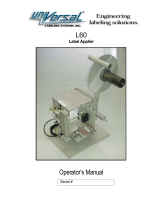
3
Table of Contents
1 Introduction ............................................................................................................................................ 4
1.1 Instructions ............................................................................................................................................... 4
1.2 Intended Use ............................................................................................................................................ 4
1.3 Safety Instructions .................................................................................................................................... 4
1.4 Safety Marking ......................................................................................................................................... 5
1.5 Environment ............................................................................................................................................. 5
2 Product Description ............................................................................................................................... 6
2.1 Function ................................................................................................................................................... 6
2.2 Important Features ................................................................................................................................... 6
2.3 Technical Data .......................................................................................................................................... 6
2.4 Device Overview ...................................................................................................................................... 7
2.5 Pads ......................................................................................................................................................... 8
2.5.1 Tamp Pads.......................................................................................................................................... 8
2.5.2 Roll-on Pads ....................................................................................................................................... 8
2.5.3 Blow Pads........................................................................................................................................... 8
3 Installation .............................................................................................................................................. 9
3.1 Contents of Delivery ................................................................................................................................. 9
3.2 Mounting the Applicator to the Printer ...................................................................................................... 9
3.3 Piercing the Universal Tamp Pad ........................................................................................................... 10
3.4 Preparing the Applicator for Using a Tamp Pad Type 1312 ................................................................... 10
3.5 Mounting the Pad ....................................................................................................................................11
3.6 Mounting the Stopper ..............................................................................................................................11
3.7 Connections ........................................................................................................................................... 12
4 Conguration ........................................................................................................................................ 13
4.1 Method for Changing the Printer Setup .................................................................................................. 13
4.2 Quick Mode for Setting the Delay Times ................................................................................................ 13
4.3 Conguration Parameters of the Applicator ........................................................................................... 14
5 Adjustments ......................................................................................................................................... 15
5.1 Mechanical Adjustments ....................................................................................................................... 15
5.1.1 Aligning the Pad ............................................................................................................................... 15
5.1.2 Adjusting the Parallelism between Pad and Dispense Edge ............................................................ 16
5.1.3 Opening the Holes on the Blow Tube ............................................................................................... 16
5.1.4 Aligning the Blow Tube ..................................................................................................................... 16
5.1.5 Adjusting the Stopper ....................................................................................................................... 17
5.2 Pneumatic Adjustments .......................................................................................................................... 18
5.2.1 Control Valves .................................................................................................................................. 18
5.2.2 Adjusting the Pad Movement Speed ................................................................................................ 19
5.2.3 Adjusting Vacuum and Supporting Air .............................................................................................. 20
5.2.4 Option pressure Reduction Valve ..................................................................................................... 20
6 Operation .............................................................................................................................................. 21
6.1 Loading Labels and Transfer Ribbon ..................................................................................................... 21
6.2 Activation of Peel-off Mode .................................................................................................................... 21
6.3 Setting the Peel Position ........................................................................................................................ 21
6.4 Test Mode Using the Pre-dispense Key without Print Job ..................................................................... 22
6.5 Test Mode Using the Pre-dispense Key with Print Job .......................................................................... 22
6.6 Standard Operation ................................................................................................................................ 23
7 PLC Interface ........................................................................................................................................ 23
7.1 Pin Assignment and Signal Description ................................................................................................. 24
7.2 Circuit Diagrams of Inputs and Outputs ................................................................................................. 26
7.3 Examples for External Circuits ............................................................................................................... 26
8 Error Messages .................................................................................................................................... 28
8.1 Error Messages of the Printer ................................................................................................................ 28
8.2 Error Messages of the Applicator ........................................................................................................... 28
9 Function of the LED in the electronics of the applicator ................................................................. 29
10 Declaration ............................................................................................................................................ 30
10.1 EC Declaration of Incorporation ............................................................................................................. 30
10.2 EC Declaration of Conformity ................................................................................................................. 31
11 Index ...................................................................................................................................................... 32






















